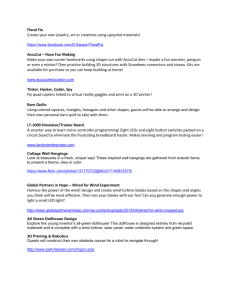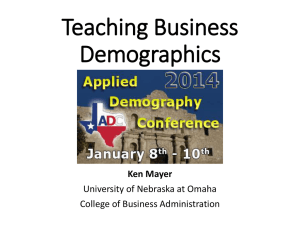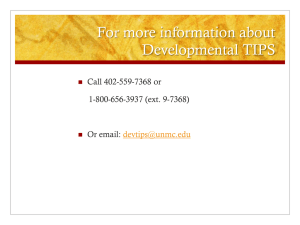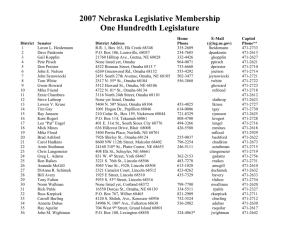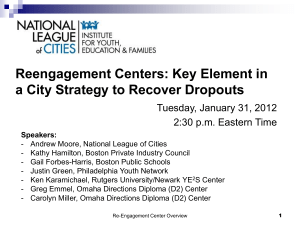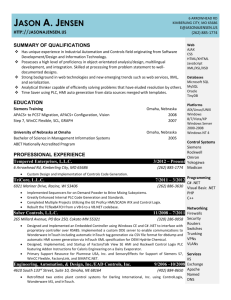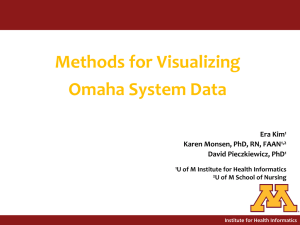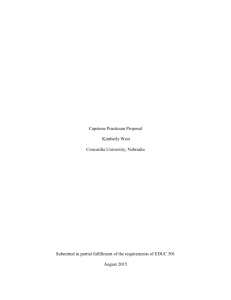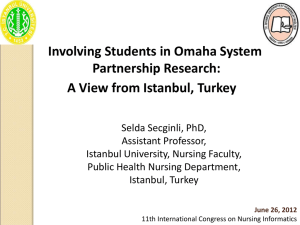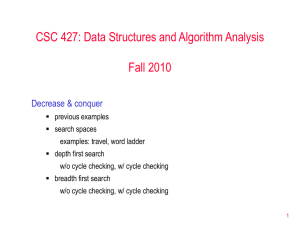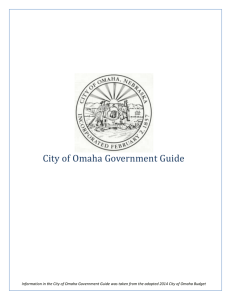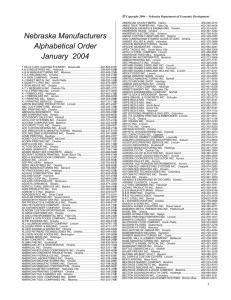Powerpoint slideshow - Minnesota Omaha System Users Group
advertisement
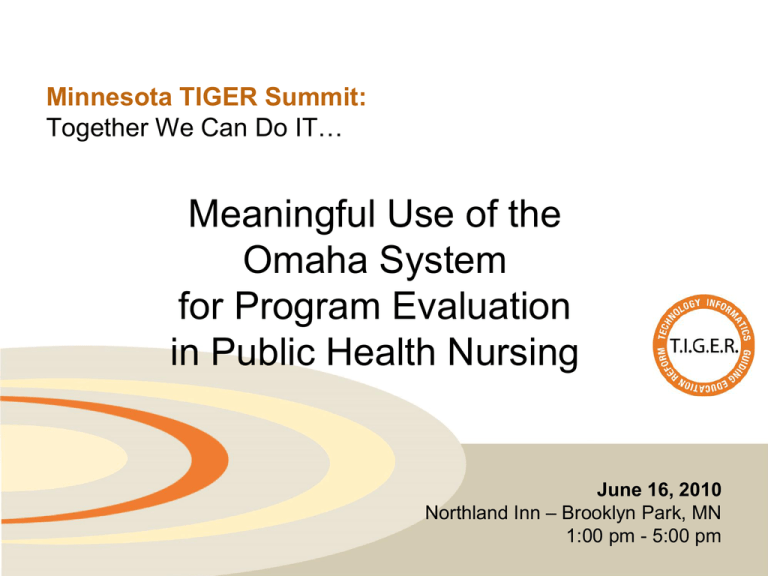
Minnesota TIGER Summit: Together We Can Do IT… Meaningful Use of the Omaha System for Program Evaluation in Public Health Nursing June 16, 2010 Northland Inn – Brooklyn Park, MN 1:00 pm - 5:00 pm Vision: Evidence-based Program Evaluation • CHS Administrators envisioned using electronic health records to gather data for program evaluation, starting in the 1990’s • 3 software programs adopted in CHS agencies – CareFacts – CHAMP – PH DOC • Common denominator: the Omaha System Minnesota Omaha System Users Group • By 2000, 87% of counties in Minnesota had a public or private agency using one of the 3 software systems • Users began to recognize the potential to work together • Minnesota Omaha System Users Group started in 2001, led by state and county public health nurses • omahasystemmn.org Diverse Stakeholders • Over 200 participants – state and local public health – private home care & hospice – Universities (faculty & students) – Software industry – Metro, central MN, southeastern MN – Wisconsin – Washington State Diverse Programs • Using the Omaha System to support programs – Family home visiting – Disease prevention and control – Waiver programs – Home care – Hospice – Healthy Communities Results • Grass roots collaboration – Internationally recognized leaders – Documentation and practice quality – Dissemination of tools – Two scientific publications – A national American Public Health Association award – International visitors Panelists/Topics • Overview – Karen Monsen, PhD, RN, University of Minnesota School of Nursing, mons0122@umn.edu • Implementation – Katie Halder, MS, RN, PHN, Douglas County Public Health katie.halder@mail.co.douglas.mn.us • Quality – Jill Timm, JD, RN, PHN, Program Manager, Maternal Child Health, Washington County Department of Public Health & Environment, jill.timm@co.washington.mn.us • Using Data – Diane Thorson, MS, RN, PHN, Director/CHS Administrator, Otter Tail County Public Health, dthorson@co.ottertail.mn.us Software • Learning curve for implementation – Computer literacy – Unique attributes of each program – Always adapting and changing – Gets easier with time and software improvements The Omaha System • Learning curve for the Omaha System – The Omaha System is the standardized language within the software – Provides structure • Client assessments • Client outcomes • Practitioner interventions Mysteries • Learning curve for both software and terminology – What is a software mystery? • Have a great relationship with vendors to solve these • Examples: Entering dailies and Omaha Interventions – What is an Omaha System terminology mystery? • Use Omaha System resources to solve these – Book – Web sites – Meetings Efficiencies • Documentation efficiency – Keeps improving – Initial charting time Outcomes • For all 3 software programs, it is the Omaha System that allows us to work together, describe our practice, and show our outcomes • Software implementation needs to include Omaha System training and support Quality • Vision to use data to demonstrate outcomes relies on having quality data • Omaha System users share this vision and have developed tools – Manuals – Pathways – KBS rating guides Manuals • Supporting documentation efficiency and quality – Provided by vendors – Adapted & edited by local agencies – Updated periodically to reflect changes – Utilized during orientation and early use of an electronic documentation system Pathways • Started in 2001 to describe practice – Helped with documentation efficiency and convenience – MOSUG pathways web page – Now developing evidence-based, peer reviewed pathways Inter-rater Reliability • Started in 2002 in Ramsey County – Based on the information in the Omaha System book – Expanded definitions for improved accuracy – Revised every 1-2 years – This summer’s revision will include Washington State Omaha System users Commitment • See the results transforming practice – Knowing standards of care – Incorporating evidence into practice – Valuing reliability and avoiding bias – Confidence in the quality of our programs as well as our data Otter Tail County Program Evaluation • Nurse-Family Partnership evaluation • Otter Tail County uses the PHDOC software program • Omaha System data • Can analyze Problems, Signs and Symptoms, Targets, and Knowledge, Behavior, and Status outcomes The Future of Omaha System Program Evaluation • • • • • LTBI Breastfeeding Obesity Early Childhood Screening MSHO Challenges • Assessment forms required with other programs do not match with the Omaha System • Working with other agencies and state officials to resolve issues in data collection • Starting to see the benefits of using standards (meaningful use of data) Nurse-Family Partnership • Serves high risk pregnant women and children ages 0-2 • Program has been carefully tested • Omaha System pathways will support our nurses • Omaha System outcomes will allow us to evaluate our local program and results Developing Standards of Care • Surveillance/Assess: Signs/Symptoms Physical: pregnancy discomforts, danger signs… • Teaching: Anatomy/Physiology: prenatal classes, childbirth preparation • Case Management: other community resources such as Quit Line, WIC Looking at the NFP data • Most Frequent Problems were Pregnancy and role Change • Most Frequent Signs/Symptoms were low income, loss of previous role, and difficulty with prenatal exercise/rest/diet/behaviors • Most Frequent Category is Teaching • Most Frequent Targets are signs/symptoms and feeding procedures Outcomes Evaluation • KBS rating data KBS Ratings Omaha System Problem Knowledge Behavior Status Av Chg Clients Av Chg Clients Av Chg Clients Pregnancy 1.1 10 -0.11 10 0.3 10 Role Change 0.38 8 0.13 8 0.13 8 Thank you! Questions?
